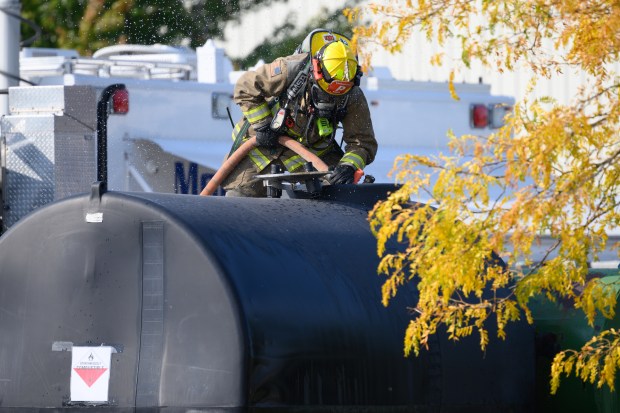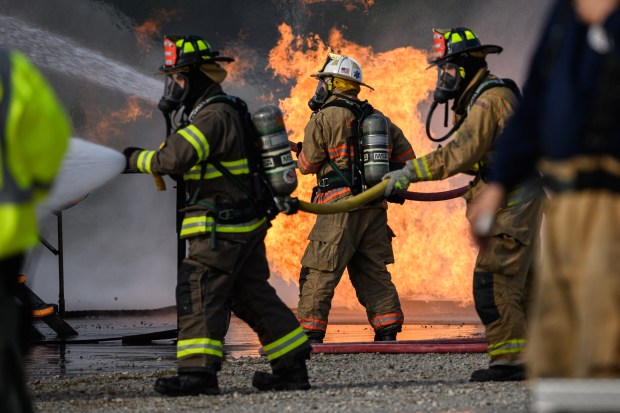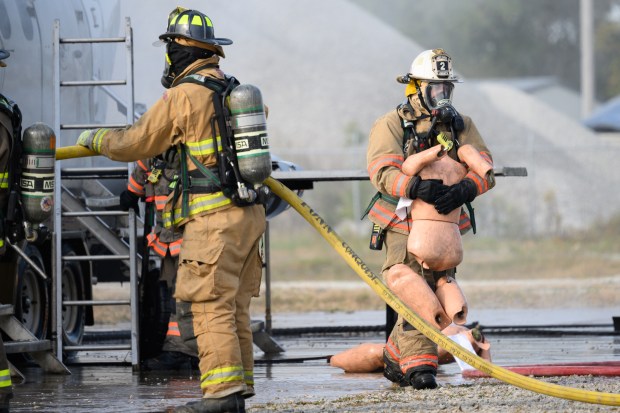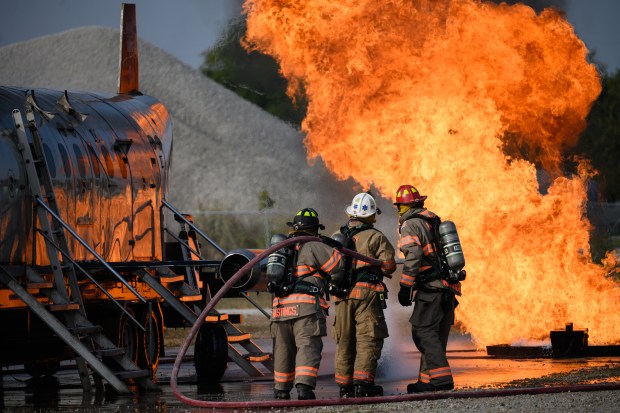First responders can’t just rush into a burning plane to rescue passengers and crew. They practiced how to accomplish that as safely as possible Saturday morning.
Porter County Municipal Airport Director Kyle Kuebler led them through an exercise that included both a plane crash and a haz-mat disaster.
The drill took place at the MAAC (Multi-Agency Academic Cooperative) training facility in Valparaiso.
Morgan, Liberty, and Washington Township firefighters douse flames during a simulated plane crash emergency as part of emergency drills at the MAAC Foundation campus on Saturday, Oct. 12, 2024. (Kyle Telechan/for the Post-Tribune)
Propane-fueled flames soared at a simulated plane crash, at one point spiraling into a firenado. A fire crew from the nearby airport arrived first, spraying foam on the flames. Then firetrucks from nearby departments joined in.
“They’re cooling the fuselage so he can make entrance,” MAAC program manager Gerry Scheff said. Firefighters can fine-tune the spay of foam or water by adjusting the nozzle.
Maneuvering inside the simulator isn’t easy. “It probably has a small aisle,” just like a small plane would, he said.

A Union Township firefighter sprays water into a simulated tank of flammable chemicals during an emergency preparedeness drill at the MAAC Foundation campus on Saturday, Oct. 12, 2024. (Kyle Telechan/for the Post-Tribune)
The plan is to reach the first victim, drag them out and perform first aid. “He can’t see because the firefighter is in a plane filled with smoke,” Scheff said.
The haz-mat situation involving a tanker provider another opportunity for the firefighters to train, spraying water to cool the tank holding a hazardous chemical.
“You can’t extinguish it, but you don’t want it blowing up,” Scheff said. “If this were a real emergency, we wouldn’t be within a mile of this.”

A firefighter pulls a rescue training manikin from a simulated fuselage during an emergency preparedeness drill at the MAAC Foundation campus on Saturday, Oct. 12, 2024. (Kyle Telechan/for the Post-Tribune)
Fire departments often use drones to safely read placards that tell what the tank contains or to see the extent of a train derailment, he said.
The placard warning of a hazardous substance inside gives a number to look up in the emergency response guide. Scheff looked it up. “If it’s yellow phosphorous, that’s nasty,” he said.
If it were an actual emergency, the fire departments and the Porter County Emergency Management Agency would have had police and the Indiana Department of Transportation closing roads. The airport likely would have been shut down, too.

Morgan, Liberty, and Washington Township firefighters cooperate to douse a simulated plane fire during an emergency preparedeness drill at the MAAC Foundation campus on Saturday, Oct. 12, 2024. (Kyle Telechan/for the Post-Tribune)
Even the National Weather Service can get involved, sending weather maps and other information by phone to guide first responders in keeping a haz-mat situation under control. “We work very closely with them on haz-mat activities,” Scheff said.
Friday night, Civil Air Patrol cadets went out looking for a plane’s black box as part of the exercise. Cadet Benjamin Brooks learned how to use direction-finding equipment to triangulate the box’s position.
In all, the emergency response drill involved about 70 people, Kuebler said.

A Liberty Township firefighter carries a rescue training manikin away from a simulated plane fire during an emergency preparedeness drill at the MAAC Foundation campus on Saturday, Oct. 12, 2024. (Kyle Telechan/for the Post-Tribune)
Plane crashes don’t happen often — the last one at the airport was in December 2018, when the pilot died — but first responders are required to train for situations like this. The Federal Aviation Administration requires the training.
The simulator used for Saturday’s drill is one of seven that travel the country for training first responders.
“Every drill you learn something,” Kuebler said. “Emergency scenes are chaotic, but it’s a controlled chaos.”
It was 30 years ago this month that American Eagle Flight 4184 crashed in a field near Roselawn. All 68 people aboard were killed. The passenger flight was on its way from Indianapolis to Chicago when it crashed because of severe icing conditions.
“That was a 2.5-month ordeal for that county to work with,” Kuebler said, and Newton County doesn’t even have an airport.
A member of the Lincoln Township Fire Department has led training multiple times to help firefighters know what responding to a plane crash can be like, said Kuebler, himself a volunteer firefighter in Kouts.
Doug Ross is a freelance reporter for the Post-Tribune.



